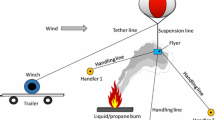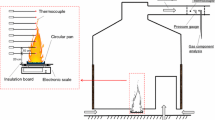Abstract
A series of experiments are conducted in a 37 cm diameter gas burner situated in a quiescent environment. Time-averaged local measurements of the temperature, velocity, soot, and gaseous species are obtained in 21kW, 34kW, and 50 kW propane fires above the burner centerline. Global measurements of the radiative fraction, flame height, soot and CO yields, and total heat feedback to the burner are also obtained. Time-averaged gaseous species concentrations are measured using a gas chromatograph with mass selectivity and thermal conductivity detectors. The time-averaged soot mass fraction is measured simultaneously via a gravimetric technique. Additional gaseous species and soot measurements are obtained in the exhaust duct via gas analyzers and laser transmission measurements, respectively. A mixture fraction analysis shows that these propane fires exhibit similar trends in which the experimental data nearly matches the idealized state relationships. Carbon monoxide concentrations obtained throughout the fire are presented as a function of mixture fraction and compared among the different propane fire sizes. The dataset provides a comprehensive picture of the mean structure of the three propane fires.









Similar content being viewed by others
Notes
Certain commercial products are identified in this work to specify adequately the equipment used. Such identification does not imply a recommendation by the authors, nor does it imply that this equipment is the best available for the purpose.
References
Brown A, Bruns M, Gollner M et al (2018) Proceedings of the first workshop organized by the IAFSS working group on measurement and computation of fire phenomena (MaCFP). Fire Saf J 101:1–17
Merci B, Torero J, Trouvé A (2016) IAFSS working group on measurement and computation of fire phenomena. Fire Technol 52(3):607–610
Merci B, Trouvé A (2019) Call for participation in the second workshop organized by the IAFSS working group on measurement and computation of fire phenomena. Fire Technol 55(6):1911–1917
McDermott R, Rein G (2016) Special issue on fire model validation. Fire Technol 52(1):1–4
Andrews G, Daham B, Mmolawa M et al (2005) FTIR investigations of toxic gases in air starved enclosed fires. Fire Saf Sci 8:1035–1046
Bundy M, Hamins A, Johnsson E et al (2007) Measurements of heat and combustion products in reduced-scale ventilation-limited compartment fires. NIST Technical Note TN 1483, National Institute of Standards and Technology, Gaithersburg, MD
Fischer S, Hardouin-Duparc B, Grosshandler W (1987) The structure and radiation of an ethanol pool fire. Combust Flame 70(3):291–306
Hamins A, Lock A (2016) The structure of a moderate-scale methanol pool fire. NIST Technical Note TN 1928, National Institute of Standards and Technology. Gaithersburg, MD
Falkenstein-Smith R, Sung K, Chen J et al (2021) The chemical structure of a 30 cm methanol pool fire. Fire Mater 45(3):429–434
Falkenstein-Smith R, Sung K, Chen J et al (2021) Chemical structure of medium-scale liquid pool fires. Fire Saf J 120(103):099
Falkenstein-Smith R, Sung K, Chen J et al (2021) Mixture fraction analysis of combustion products in medium-scale pool fires. Proc Combust Inst 38(3):4935–4942
Orloff L, Ris JD, Delichatsios M (1988) General correlations of chemical species in turbulent fires. Proc Combust Inst 21(1):101–109
Orloff L, Ris JD, Delichatsios M (1987) Chemical effects on molecular species concentrations in turbulent fires. Combust Flame 69(3):273–289
Falkenstein-Smith R, Sung K, Chen J et al (2021) The structure of medium-scale pool fires, Second Edition. NIST Technical Note TN 2082e2, National Institute of Standards and Technology, Gaithersburg, MD
Bilger R (1977) Reaction rates in diffusion flames. Combust Flame 30:277–284
Peters N (1984) Laminar diffusion flamelet models in non-premixed turbulent combustion. Prog Energy Combust Sci 10(3):319–339
Hamins A, Seshadri K (1987) The structure of diffusion flames burning pure, binary, and ternary solutions of methanol, heptane, and toluene. Combust Flame 68(3):295–307
Sivathanu Y, Faeth GM (1990) Generalized state relationships for scalar properties in non-premixed hydrocarbon/air flames. Combust Flame 82(2):211–230
Incropera F, Lavine A, Bergman T et al (2011) Fundamentals of heat and mass transfer, 6th edn. Wiley, Hoboken, NJ, USA
Hamins A (2016) Energetics of small and moderate-scale gaseous pool fires. NIST Technical Note TN 1926, National Institute of Standards and Technology. Gaithersburg, MD
Schneider CA, Rasband WS, Eliceiri KW (2012) NIH image to ImageJ: 25 years of image analysis. Nat Methods 9(7):671–675
Otsu N (1979) A threshold selection method from gray-level histograms. IEEE Trans Syst Man Cybern 9(1):62–66
Modak AT (1977) Thermal radiation from pool fires. Combust Flame 29:177–192
Shaddix C, Allendorf S, Hubbard G et al (2001) Diode laser diagnostics for gas species and soot in large pool fires. Tech. Rep. SAND2001-8383, Sandia National Laboratories, Livermore, CA
Shaddix C (1999) Correcting thermocouple measurements for radiation loss: a critical review. Tech. Rep. CONF-990805, Sandia National Laboratories, Livermore, CA
Sung K, Falkenstein-Smith R, Hamins A et al (2021) Velocity and temperature structure of medium-scale pool fires. NIST Technical Note TN 2162, National Institute of Standards and Technology, Gaithersburg, MD
Vines R (2012) The platinum metals and their alloys. Literary Licensing, LLC
Jaeger F, Rosenbohm E (1939) The exact formulae for the true and mean specific heats of platinum between 0 and 1600 c. Physica 6:1123–1125
Choi M, Mulholland G, Hamins A et al (1995) Comparisons of the soot volume fraction using gravimetric and light extinction techniques. Combust Flame 102(1–2):161–169
Mulholland G, Johnsson E, Fernandez MG et al (2000) Design and testing of a new smoke concentration meter. Fire Mater 24(5):231–243
Mulholland GW, Croarkin C (2000) Specific extinction coefficient of flame generated smoke. Fire Mater 24(5):227–230
Bryant R, Bundy M (2019) The NIST 20 mw calorimetry measurement system for large-fire research. NIST Technical Note TN 2077, National Institute of Standards and Technology, Gaithersburg, MD
Hurley M (ed) (2016) SFPE handbook of fire protection engineering, 5th ed., Society of Fire Protection Engineers, Springer, New York
Heskestad G (1983) Luminous heights of turbulent diffusion flames. Fire Saf J 5(2):103–108
Baum HR, McCaffrey B (1989) Fire induced flow field-theory and experiment. Fire Saf Sci 2:129–148
Köylü ÜÖ, Faeth GM (1991) Carbon monoxide and soot emissions from liquid-fueled buoyant turbulent diffusion flames. Combust Flame 87(1):61–76
Acknowledgements
The authors are grateful to Matthew Bundy and Artur Chernovsky of NIST for their expertise, setting up the data collection, exhaust measurement, and data archiving systems and to Marco Fernandez and Laurean DeLauter for their help conducting the experiments.
Author information
Authors and Affiliations
Corresponding author
Ethics declarations
Competing interest
The authors declare that they have no known competing financial interests or personal relationships that could have appeared to influence the work reported in this paper.
Additional information
Publisher's Note
Springer Nature remains neutral with regard to jurisdictional claims in published maps and institutional affiliations.
Supplementary Information
Below is the link to the electronic supplementary material.
Rights and permissions
About this article
Cite this article
Falkenstein-Smith, R.L., Sung, K. & Hamins, A. Characterization of Medium-Scale Propane Pool Fires. Fire Technol 59, 1865–1882 (2023). https://doi.org/10.1007/s10694-023-01412-9
Received:
Accepted:
Published:
Issue Date:
DOI: https://doi.org/10.1007/s10694-023-01412-9




